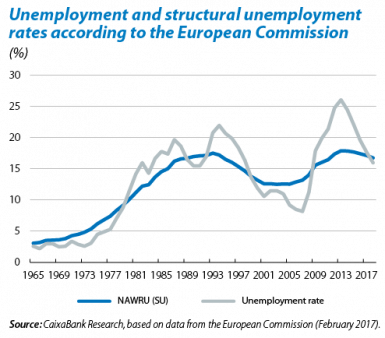Structural unemployment in Spain
The Spanish economy’s strong growth in over the past two years has acted as a boost for job creation. In the period 2015-2016, the number of employees rose by 939,000 people. But unemployment is still very high (18.6% in Q4 2016) and it is not obvious which part of this has become structural.
Formally, structural unemployment (SU) is the unemployment rate compatible with an inflation rate close to the central bank’s target and it is therefore also known as the non-accelerating inflation rate of unemployment (NAIRU) or non-accelerating wage rate of unemployment (NAWRU). SU cannot be observed directly but is estimated based on the relationship between unemployment and inflation throughout the economic cycle, also known as the Phillips curve. In the short-term, unemployment below its structural level pushes up prices and wages, and vice versa. SU is difficult to estimate because it can vary over time depending on changes in institutional and economic factors. For instance, more flexible labour regulations can reduce SU while a permanent shock in a specific industry, such as construction, can increase it.
The first chart shows the trend in Spain’s unemployment rate together with the latest NAWRU estimate by the European Commission, in February 2017. As can be seen, the unemployment rate rises more quickly than structural unemployment during periods of crisis, suggesting that unemployment essentially increases due to cyclical factors. But part of this increase may also be structural, especially when accompanied by higher long-term unemployment as this can depreciate the human capital. According to the European Commission, NAWRU is currently 17.2% and, without reforms, will fall slightly to 16.8% next year. This figure is actually higher than the unemployment forecast for 2018 (16.0%), suggesting that wage pressure may increase over the coming quarters.
This estimate should be used with care, however. First, the current conditions of Spain’s economy, and particularly its labour market, suggest the Commission may be overestimating NAWRU. No significant pressure can be seen on prices or wages, for instance core inflation is still close to 1% and February’s wage agreements contain a moderate rise of 1.2%. Secondly, estimates of structural unemployment are also renowned for being unreliable, especially when specific regulatory measures are applied in the labour market, as it is difficult to estimate their impact on SU in real time. Evidence of this unreliability can be seen in how NAWRU estimates have altered year after year. As shown by the second chart, even the Commission’s estimates have been successively downgraded as new data become available. The OECD, using a slightly different methodology, provides a 15.7% SU estimate for 2016,1 considerably lower than the European Commission’s figure.
Irrespective of the methodology used, international comparisons indicate that Spain’s structural unemployment is the highest among European countries, even exceeding Greece (16.0%) and Portugal (10.3%) in 2016. This underlines the need to continue exploring measures that can help to reduce Spain’s SU further. Measures which would certainly improve the situation are active employment policies as well as skills education and worker training. They could also count on widespread political backing.
1. OECD, 2016, Economic Outlook No. 100, November.





